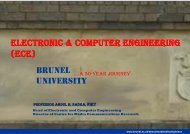DEliverable 2.3 - the School of Engineering and Design - Brunel ...
DEliverable 2.3 - the School of Engineering and Design - Brunel ...
DEliverable 2.3 - the School of Engineering and Design - Brunel ...
Create successful ePaper yourself
Turn your PDF publications into a flip-book with our unique Google optimized e-Paper software.
ICT Project 3D VIVANT– Deliverable <strong>2.3</strong><br />
Contract no.:<br />
248420<br />
User Acceptance Validation Plan<br />
Table 2, cont.: Testplan End-Users<br />
Tests Month Methodology Location -<br />
Partners<br />
Testers<br />
Test Content<br />
Broadcast<br />
Hyperlinked 3D<br />
video<br />
M31 – M34<br />
(September<br />
– November<br />
2012)<br />
M31 – M34<br />
(September<br />
– November<br />
2012)<br />
End-Users: Complete Implemented Showcase Test<br />
Questionnaires,<br />
focus groups<br />
Questionnaires,<br />
task-centred<br />
testing, <strong>the</strong><br />
thinking aloud<br />
method <strong>and</strong><br />
observations<br />
Potsdam,<br />
RBB<br />
Potsdam,<br />
RBB<br />
Representative<br />
sample <strong>of</strong> show<br />
case service<br />
end-users<br />
Representative<br />
sample <strong>of</strong> show<br />
case service<br />
end-users<br />
Implemented<br />
showcase including<br />
3D holoscopic video<br />
<strong>and</strong> 3D audio<br />
Implemented<br />
showcase including<br />
3D hyperlinked video<br />
Two possible test scenarios for end-user visual tests, which should be reflected in <strong>the</strong> above table, are:<br />
i. How does <strong>the</strong> 3D holoscopic content compare to stereoscopic 3D content (generated using<br />
conventional stereoscopic technology); <strong>and</strong><br />
ii. How does <strong>the</strong> stereoscopic content extracted from <strong>the</strong> 3D holoscopic content compare to<br />
stereo content generated using conventional stereoscopic technology.<br />
The importance <strong>of</strong> <strong>the</strong> second point is related to <strong>the</strong> fact that, if it can be shown that <strong>the</strong> stereoscopic<br />
3D content extracted from 3D holoscopic content is comparable to stereoscopic content generated<br />
using conventional stereoscopic imaging techniques, <strong>the</strong>n <strong>the</strong> production <strong>of</strong> 3D stereo becomes easier<br />
(i.e., no need for multiple cameras <strong>and</strong> calibration problems).<br />
Using computer generated content will be an easier option because it is possible to use <strong>the</strong> same<br />
models generated in 3ds Max ® <strong>and</strong> carry out <strong>the</strong> rendering using existing plug-in tools for<br />
stereoscopic <strong>and</strong> <strong>the</strong> plug-in tools developed by <strong>Brunel</strong> University for holoscopic content. Hence, <strong>the</strong><br />
same content is generated <strong>and</strong> displayed by <strong>the</strong> two technologies.<br />
For real data, a concept which will allow <strong>the</strong> same content to be captured using <strong>the</strong> holoscopic camera<br />
<strong>and</strong> a pair <strong>of</strong> 2D cameras is needed. One way to achieve this is by using a motion control system <strong>and</strong><br />
program a camera movement when capturing a static scene to simulate motion: 1st take will be with<br />
<strong>the</strong> 3D holoscopic camera <strong>and</strong> <strong>the</strong> 2nd take will be with a pair <strong>of</strong> stereo cameras.<br />
5.2 TIME PLAN<br />
The time plan for <strong>the</strong> tests corresponds to <strong>the</strong> timing <strong>of</strong> Task 7.3 – “User Perception <strong>and</strong> Usability<br />
Testing”, which starts in project month 29 <strong>and</strong> continues until month 34. The exceptions are <strong>the</strong> tasks<br />
to be carried out by <strong>Brunel</strong> University on viewing <strong>and</strong> a small number <strong>of</strong> earlier tests at RBB focusing<br />
on <strong>the</strong> optimisation <strong>of</strong> <strong>the</strong> processes before involving costly pr<strong>of</strong>essional teams. The timing for <strong>the</strong>se<br />
tests is earlier to correspond with <strong>the</strong> availability <strong>of</strong> enough test c<strong>and</strong>idates <strong>and</strong> personnel <strong>and</strong> also to<br />
provide useful input at an earlier stage.<br />
The pr<strong>of</strong>essional user tests are planned at <strong>the</strong> start <strong>of</strong> <strong>the</strong> task so <strong>the</strong> time gap between producing <strong>the</strong><br />
showcases <strong>and</strong> developing <strong>and</strong> using <strong>the</strong> test-bed is not too great, <strong>and</strong> <strong>the</strong> experience is still fresh in<br />
<strong>the</strong> c<strong>and</strong>idates’ minds.<br />
The end-user tests with <strong>the</strong> individual elements <strong>of</strong> <strong>the</strong> system are timed at <strong>the</strong> beginning <strong>of</strong> <strong>the</strong> task to<br />
allow feedback <strong>and</strong> refining <strong>of</strong> <strong>the</strong> testing concept if necessary for <strong>the</strong> final end-user tests with <strong>the</strong><br />
01.09.11 24
















